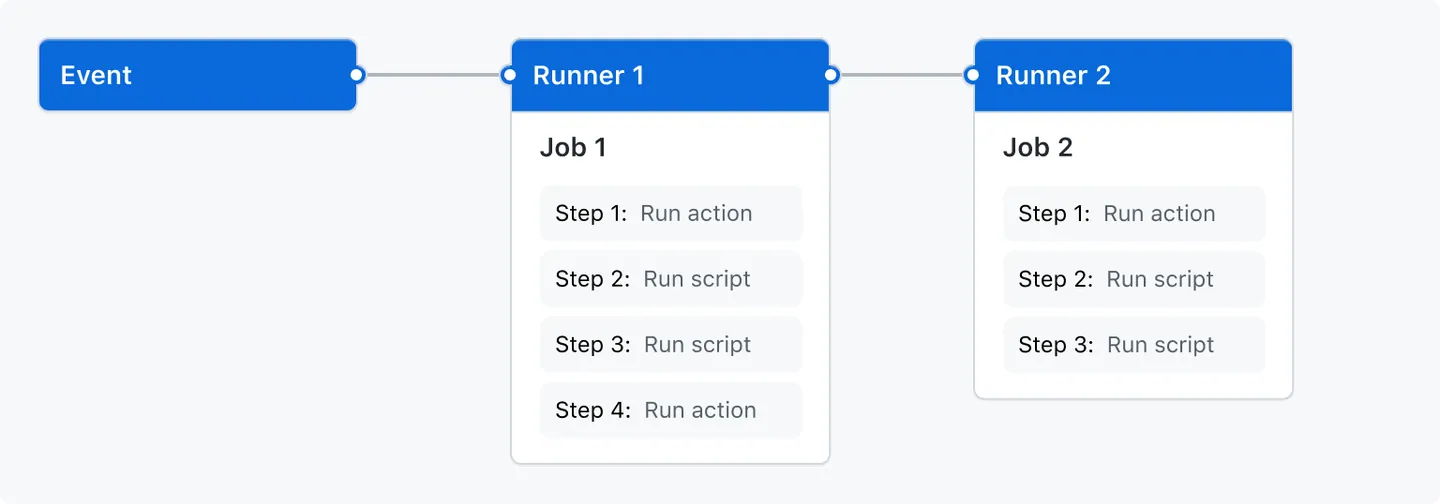GitHub Actions - Introduction
GitHub Actions - Introduction
Introduction
- GitHub Actions is a continuous integration and continuous delivery (CI/CD) platform that allows you to automate your build, test, and deployment pipeline.
- You can create workflows that build and test every pull request to your repository, or deploy merged pull requests to production.
- GitHub Actions goes beyond just DevOps and lets you run workflows when other events happen in your repository.
- GitHub provides Linux, Windows, and macOS virtual machines to run your workflows, or you can host your own self-hosted runners in your own data center or cloud infrastructure.
Components of GitHub Actions
- You can configure a GitHub Actions workflow to be triggered when an event occurs in your repository, such as a pull request being opened or an issue being created.
- Your workflow contains one or more jobs which can run in sequential order or in parallel.
- Each job will run inside its own virtual machine runner, or inside a container, and has one or more steps that either run a script that you define or run an action, which is a reusable extension that can simplify your workflow.
- Workflow
- A workflow is a configurable automated process that will run one or more jobs.
- Workflows are defined by a YAML file checked in to your repository and will run when triggered by an event in your repository, or they can be triggered manually, or at a defined schedule.
- Workflows are defined in the
.github/workflowsdirectory in a repository. A repository can have multiple workflows, each which can perform a different set of tasks such as:- Building and testing pull requests.
- Deploying your application every time a release is created.
- Adding a label whenever a new issue is opened.
- You can reference a workflow within another workflow.
- Events
- An event is a specific activity in a repository that triggers a workflow run. For example, an activity can originate from GitHub when someone creates a pull request, opens an issue, or pushes a commit to a repository.
- You can also trigger a workflow to run on a schedule, by posting to a REST API, or manually.
- Jobs
- A job is a set of steps in a workflow that is executed on the same runner.
- Each step is either a shell script that will be executed, or an action that will be run.
- Steps are executed in order and are dependent on each other.
Since each step is executed on the same runner, you can share data from one step to another. For example, you can have a step that builds your application followed by a step that tests the application that was built.
- You can configure a job’s dependencies with other jobs; by default, jobs have no dependencies and run in parallel.
- Actions
- An action is a custom application for the GitHub Actions platform that performs a complex but frequently repeated task.
- Use an action to help reduce the amount of repetitive code that you write in your workflow files.
- An action can pull your Git repository from GitHub, set up the correct toolchain for your build environment, or set up the authentication to your cloud provider.
- Runners
- A runner is a server that runs your workflows when they’re triggered.
- Each runner can run a single job at a time.
- GitHub provides Ubuntu Linux, Microsoft Windows, and macOS runners to run your workflows. Each workflow run executes in a fresh, newly-provisioned virtual machine.
- GitHub also offers larger runners, which are available in larger configurations.
- If you need a different operating system or require a specific hardware configuration, you can host your own runners.
This post is licensed under CC BY 4.0 by the author.
